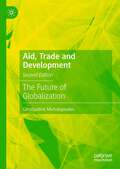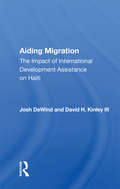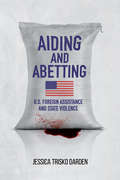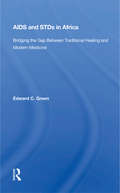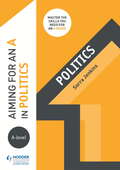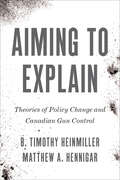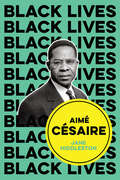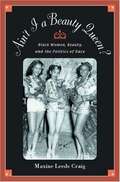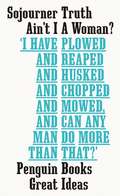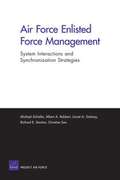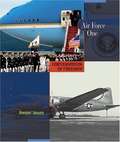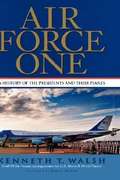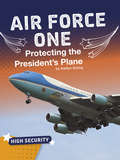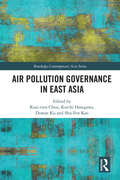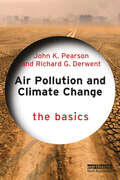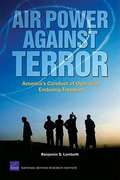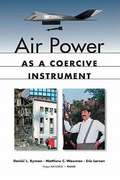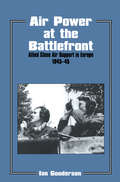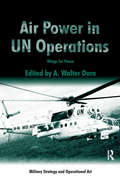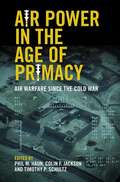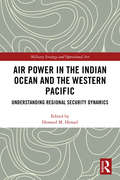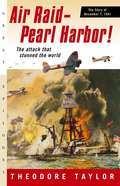- Table View
- List View
Aid, Trade and Development: 50 Years of Globalization
by Constantine MichalopoulosThis enlightening book offers a comprehensive historical analysis of the main development challenges of the last half century and the international community's response through aid and trade. Much has happened: the oil crises of the 1970s, the debt crises of the 1980s, the break-up of the Soviet Union in the 1990s, the Millennium Development Goals, the onslaught of Globalization and the rise of its opponents since the financial crisis of the 2000s. Through it all, development has spread and global poverty declined. The volume assesses the contributions and coherence of developing and developed country policies and the role played by global institutions entrusted with responsibilities to enhance trade and support development. The volume concludes with a focus on the prospects for the future and the changes needed to make globalization more equitable. With 50 years of professional experience in the World Bank, the WTO and bilateral aid agencies, Michalopoulos brings an insider's perspective on the workings of these institutions and what needs to be done to make them more effective and responsive to changing global needs.
Aid, Trade and Development: The Future of Globalization
by Constantine MichalopoulosThis volume presents a broad sweep of modern economic history underpinning aid, trade, development and globalization in the last half century and the salient challenges facing the global community today. The author draws on his long years as an academic and development practitioner to recommend what needs to be done to cope with the backsliding of the fight against global poverty, fractured geopolitics and the threats to the multilateral economic order. The new, revised edition analyses how unilateralism, rising protectionism and the Covid-19 pandemic seriously threaten global sustainable development. It concludes with recommendations on the policy changes needed to make globalization more equitable and development more sustainable. This book will be of interest to researchers and students of economic development and economic history, as well as all those concerned about global inequality and sustainability.
Aiding Migration: The Impact Of International Development Assistance On Haiti
by Josh DeWindThis book examines the political and economic legacy of the Duvalier regime with the intention of clarifying its implications for Haiti's development. It states that reforming the nation's economic development strategy to address the needs of the poor is one of the political task of Haitians.
Aiding and Abetting: U.S. Foreign Assistance and State Violence
by Jessica Trisko DardenThe United States is the world's leading foreign aid donor. Yet there has been little inquiry into how such assistance affects the politics and societies of recipient nations. Drawing on four decades of data on U.S. economic and military aid, Aiding and Abetting explores whether foreign aid does more harm than good. Jessica Trisko Darden challenges long-standing ideas about aid and its consequences, and highlights key patterns in the relationship between assistance and violence. She persuasively demonstrates that many of the foreign aid policy challenges the U.S. faced in the Cold War era, such as the propping up of dictators friendly to U.S. interests, remain salient today. Historical case studies of Indonesia, El Salvador, and South Korea illustrate how aid can uphold human freedoms or propagate human rights abuses. Aiding and Abetting encourages both advocates and critics of foreign assistance to reconsider its political and social consequences by focusing international aid efforts on the expansion of human freedom.
Aids And STDs In Africa: Bridging The Gap Between Traditional Healing And Modern Medicine
by Edward C GreenThis book emphasizes the factors in the spread and control of AIDS that have received less attention in the literature. It suggests that a collaborative action program involving traditional healers is necessary if we wish to impact the spread of AIDS and other STDs in Africa.
Aiming for an A in A-level Politics
by Sarra JenkinsExam Board: AQA, Edexcel, WJEC/Eduqas Level: A-level Subject: Politics First teaching: September 2017 First exams: Summer 2019 Master the skills you need to set yourself apart and hit the highest grades; this year-round course companion develops the higher-order thinking skills that top-achieving students possess, providing step-by-step guidance, examples and tips for getting an A grade.Written by experienced author and teacher Sarra Jenkins, Aiming for an A in A-level Politics:Helps you develop the 'A grade skills' of analysis, evaluation, creation and applicationTakes you step by step through specific skills you need to master in A-level Politics, so you can apply these skills and approach each exam question as an A/A* candidateClearly shows how to move up the grades with sample responses annotated to highlight the key features of A/A* answersHelps you practise to achieve the levels expected of top-performing students, using in-class or homework activities and further reading tasks that stretch towards university-level studyPerfects exam technique through practical tips and examples of common pitfalls to avoid Cultivates effective revision habits for success, with tips and strategies for producing and using revision resourcesSupports the major exam boards, outlining the Assessment Objectives for reaching the higher levels under the AQA, Edexcel and WJEC/Eduqas specifications.
Aiming for an A in A-level Politics
by Sarra JenkinsExam Board: AQA, Edexcel, WJEC/Eduqas Level: A-level Subject: Politics First teaching: September 2017 First exams: Summer 2019 Master the skills you need to set yourself apart and hit the highest grades; this year-round course companion develops the higher-order thinking skills that top-achieving students possess, providing step-by-step guidance, examples and tips for getting an A grade.Written by experienced author and teacher Sarra Jenkins, Aiming for an A in A-level Politics:Helps you develop the 'A grade skills' of analysis, evaluation, creation and applicationTakes you step by step through specific skills you need to master in A-level Politics, so you can apply these skills and approach each exam question as an A/A* candidateClearly shows how to move up the grades with sample responses annotated to highlight the key features of A/A* answersHelps you practise to achieve the levels expected of top-performing students, using in-class or homework activities and further reading tasks that stretch towards university-level studyPerfects exam technique through practical tips and examples of common pitfalls to avoid Cultivates effective revision habits for success, with tips and strategies for producing and using revision resourcesSupports the major exam boards, outlining the Assessment Objectives for reaching the higher levels under the AQA, Edexcel and WJEC/Eduqas specifications.
Aiming to Explain: Theories of Policy Change and Canadian Gun Control
by B. Timothy Heinmiller Matthew A. HennigarFirearms policy has periodically dominated Canadian politics since the late 1960s. Compared to the United States, however, there is little scholarship on firearms policy to the neighbouring north. Using Canadian firearms policy, Aiming to Explain examines five prominent policy process theories employed during the period from the 1989 Montreal Massacre to the 2012 cancellation of the universal firearms registry. Throughout, B. Timothy Heinmiller and Matthew A. Hennigar present rigorous applications of rational choice institutionalism, social constructivism, the advocacy coalition framework, the multiple streams framework, and punctuated equilibrium. The investigations draw on method-based best practices, while also making use of a wide range of data collection and analysis techniques, including inferential statistics, descriptive statistics, process tracing, congruence analysis, and qualitative content analysis. The goal of Aiming to Explain is not to select a single best theory, but to compare their relative strengths and weaknesses in an effort to direct future research and theoretical development efforts in the study of Canadian public policy.
Aimé Césaire: Inventor of Souls (Black Lives)
by Jane HiddlestonAimé Césaire is arguably the greatest Caribbean literary writer in history. Best known for his incendiary epic poem Notebook of a Return to My Native Land, Césaire reinvented black culture by conceiving ‘négritude’ as a dynamic and continuous process of self-creation. In this essential new account of his life and work, Jane Hiddleston introduces readers to Césaire’s unique poetic voice and to his role as a figurehead for intellectuals pursuing freedom and equality for black people. Césaire was deeply immersed in the political life of his native Martinique for over fifty years: as Mayor of Fort-de-France and Deputy at the French National Assembly, he called for the liberation of oppressed people at home and abroad, while celebrating black creativity and self-invention to resist a history of racism. Césaire’s extraordinary life reminds us that the much-needed revolt against oppression and subjugation can—and should—come from within the establishment, as well as without.
Ain't I A Beauty Queen?: Black Women, Beauty, and the Politics of Race
by Maxine Leeds Craig"Black is Beautiful!" The words were the exuberant rallying cry of a generation of black women who threw away their straightening combs and adopted a proud new style they called the Afro. The Afro, as worn most famously by Angela Davis, became a veritable icon of the Sixties. Although the new beauty standards seemed to arise overnight, they actually had deep roots within black communities. Tracing her story to 1891, when a black newspaper launched a contest to find the most beautiful woman of the race, Maxine Leeds Craig documents how black women have negotiated the intersection of race, class, politics, and personal appearance in their lives. Craig takes the reader from beauty parlors in the 1940s to late night political meetings in the 1960s to demonstrate the powerful influence of social movements on the experience of daily life. With sources ranging from oral histories of Civil Rights and Black Power Movement activists and men and women who stood on the sidelines to black popular magazines and the black movement press, Ain't I a Beauty Queen'will fascinate those interested in beauty culture, gender, class, and the dynamics of race and social movements.
Ain't I A Woman? (Penguin Great Ideas)
by Sojourner Truth'I am a woman's rights. I have plowed and reaped and husked and chopped and mowed, and can any man do more than that? I am as strong as any man that is now'A former slave and one of the most powerful orators of her time, Sojourner Truth fought for the equal rights of Black women throughout her life. This selection of her impassioned speeches is accompanied by the words of other inspiring African-American female campaigners from the nineteenth century.One of twenty new books in the bestselling Penguin Great Ideas series. This new selection showcases a diverse list of thinkers who have helped shape our world today, from anarchists to stoics, feminists to prophets, satirists to Zen Buddhists.
Air Force Enlisted Force Management
by Albert A. Robbert Richard E. Stanton Christine San Lionel A. Galway Michael SchieferA fundamental goal of the Air Force personnel system is to ensure that the manpower inventory, by Air Force specialty code and grade, matches requirements. However, there are structural obstacles that impede achieving this goal. To remove one of those obstacles, the authors propose a methodology that would marginally modify grade authorizations within skill levels to make it possible to better achieve manpower targets.
Air Force One (Cornerstones of Freedom, 2nd Series)
by Brendan JanuaryChildren's book about Air Force One, the airplane that the President of the United States uses for transportation.
Air Force One: A History of the Presidents and Their Planes
by Kenneth T. WalshFrom FDR's prop-driven Pan Am to the glimmering blue and white jumbo 747 on which George W. Bush travels, the president's plane has captured the public's awe and imagination, and is recognized around the world as a symbol of American power. In this unique book, Kenneth Walsh looks at the decisions that our last 12 presidents made on the plane; the personality traits and peccadilloes they revealed when their guard was down; and the way they each established a distinctive mood aboard that was a reflection of their times, as well as their individual personalities. Based on interviews with four living presidents, scores of past and present White House officials, and staff and crew members of Air Force One, Walsh's book reveals countless fascinating stories of life aboard the 'flying White House.' It also features descriptions of the food, the decor, the bedrooms, the medical clinic, and much more.
Air Force One: Protecting the President's Plane (High Security)
by Kaitlyn DulingAir Force One keeps the U.S. president safe while flying. Learn more about the features that protect this amazing plane. Also find out how team members protect the president as he travels on Air Force One.
Air Pollution Governance in East Asia (Routledge Contemporary Asia Series)
by Kuei-Tien Chou Koichi Hasegawa Dowan Ku Shu-Fen KaoFocussing on Taiwan, South Korea, Japan and Mainland China, the contributors to this book analyse various cases of air pollution within East Asia. Air pollution in East Asia is a major health risk, which also has damaging impacts on the environment leading to impacts on society, economic growth and welfare. While existing laws and policies have made progress in alleviating air pollution in each country in the region, the protection of favourable environments and he resolution of transboundary air pollution problems have become major targets of regional cooperation. Combining perspectives from social sciences and science, technology, society studies, the contributors to this book examine both the technical and socio-economic-political aspects of these challenges, through a range of case studies from around the region. A valuable read for researchers and policy-makers looking at air pollution and transboundary governance challenges within and beyond East Asia.
Air Pollution and Climate Change: The Basics (The Basics)
by John K. Pearson Richard DerwentThis book identifies four key forms of air pollution: indoor, urban, regional and global. It discusses how these four types of pollution are manifest in today’s society and examines the scientific and policy challenges that stand in the way of progress. Written in a style that balances scientific underpinnings with accessible language, Pearson and Derwent examine the sources and historical context of air pollutants, before dedicating a chapter to each of the key forms. Armed with these basics, they begin to address the challenges faced by improving indoor, urban and regional air quality, whilst reducing global warming in the years ahead. This leads to a greater understanding of the challenges of global climate change, with new proposals for reducing global warming. However, the authors conclude that it is only when we have a scenario of reforestation combined with reductions in emissions of all greenhouse gases that real progress will be made in the fight against climate change. Then, air pollution will also be consigned to history. With a foreword written by Professor James Lovelock, this book will be of great interest to students and scholars of climate change and environmental policy, as well as air quality professionals working in this important field.
Air Power Against Terror: America's Conduct of Operation Enduring Freedom
by Benjamin S. LambethThe terrorist attacks of 9/11 plunged the United States into a determined counteroffensive against Osama bin Laden and his al Qaeda terrorist network. This report details the initial U.S. military response to those attacks, namely, the destruction of al Qaeda?'s terrorist infrastructure and the removal of the ruling Taliban regime in Afghanistan. The author emphasizes several distinctive achievements in this war, including the use of precision air-delivered weapons that were effective irrespective of weather, the first combat use of Predator unmanned aerial vehicles armed with Hellfire missiles, and the integrated employment of high-altitude drones and other air- and space-based sensors that gave CENTCOM unprecedented round-the-clock awareness of enemy activity.
Air Power as a Coercive Instrument
by Ian O. Lesser Keith Crane Seth G. Jones Rollie Lal John G. Mcginn Daniel BymanCoercion--the use of threatened force to induce an adversary to change its behavior--is a critical function of the U.S. military. U.S. forces have recently fought in the Balkans, the Persian Gulf, and the Horn of Africa to compel recalcitrant regimes and warlords to stop repression, abandon weapons programs, permit humanitarian relief, and otherwise modify their actions. Yet despite its overwhelming military might, the United States often fails to coerce successfully. This report examines the phenomenon of coercion and how air power can contribute to its success. Three factors increase the likelihood of successful coercion: (1) the coercer's ability to raise the costs it imposes while denying the adversary the chance to respond (escalation dominance); (2) an ability to block an adversary's military strategy for victory; and (3) an ability to magnify third-party threats, such as internal instability or the danger posed by another enemy. Domestic political concerns (such as casualty sensitivity) and coalition dynamics often constrain coercive operations and impair the achievement of these conditions. Air power can deliver potent and credible threats that foster the above factors while neutralizing adversary counter-coercive moves. When the favorable factors are absent, however, air power--or any other military instrument--will probably fail to coerce. Policymakers' use of coercive air power under inauspicious conditions diminishes the chances of using it elsewhere when the prospects of success would be greater.
Air Power at the Battlefront: Allied Close Air Support in Europe 1943-45 (Studies in Air Power #Vol. 6)
by Dr Ian GoodersonIan Gooderson presents a study of close air support in World War II, with the analysis focusing on the use of tactical air power by British and American forces during the campaigns in Italy and northwestern Europe between 1943 and 1945.
Air Power in UN Operations: Wings for Peace (Military Strategy and Operational Art)
by A. Walter DornAir power for warfighting is a story that's been told many times. Air power for peacekeeping and UN enforcement is a story that desperately needs to be told. For the first-time, this volume covers the fascinating range of aerial peace functions. In rich detail it describes: aircraft transporting vital supplies to UN peacekeepers and massive amounts of humanitarian aid to war-affected populations; aircraft serving as the 'eyes in sky' to keep watch for the world organization; and combat aircraft enforcing the peace. Rich poignant case studies illuminate the past and present use of UN air power, pointing the way for the future. This book impressively fills the large gap in the current literature on peace operations, on the United Nations and on air power generally.
Air Power in the Age of Primacy: Air Warfare since the Cold War
by Timothy P. Schultz Phil M. Haun Colin F. JacksonSince the end of the Cold War the United States and other major powers have wielded their air forces against much weaker state and non-state actors. In this age of primacy, air wars have been contests between unequals and characterized by asymmetries of power, interest, and technology. This volume examines ten contemporary wars where air power played a major and at times decisive role. Its chapters explore the evolving use of unmanned aircraft against global terrorist organizations as well as more conventional air conflicts in Bosnia, Kosovo, Afghanistan, Iraq, Lebanon, Libya, Yemen, Syria, and against ISIS. Air superiority could be assumed in this unique and brief period where the international system was largely absent great power competition. However, the reliable and unchallenged employment of a spectrum of manned and unmanned technologies permitted in the age of primacy may not prove effective in future conflicts.
Air Power in the Age of Total War (Warfare and History)
by John BuckleyWarfare in the first half of the 20th century was fundamentally and irrovocably altered by the birth and subsequent development of air power. This work assesses the role of air power in changing the face of battle on land and sea. Utilizing late-1990s research, the author demonstrates that the phenomenon of air power was both a cause and a crucial accelerating factor contributing to the theory and practice of total war. For instance, the expansion of warfare to the homefront was a direct result of bombing and indirectly due to the extent of national economic mobilization required to support first rate air power status. In addition, the move away from the principle of total war with the onset of the Cold War and the replacement of air power by ICBMs is thoroughly examined. This work should provide students of international history, war studies, defence and strategic studies with an insight into 20th-century warfare.
Air Power in the Indian Ocean and the Western Pacific: Understanding Regional Security Dynamics (Military Strategy and Operational Art)
by Howard M. HenselThis book examines the security dynamics of the Indian Ocean and the Western Pacific, concentrating upon an analysis and evaluation of the air power capabilities of the various powers active in the two regions. The volume is designed to help improve understanding of the heritage and contemporary challenges confronting the global community in the Indian Ocean and the Western Pacific, as well as to illuminate the policies of the various powers involved in the affairs of these regions, and the military capabilities that are available in support of those policies. The 16 individual chapters examine both the traditional and the non-traditional threats that confront the various Indian Ocean and Western Pacific powers, and assess the roles played by land-based and naval, fixed-wing and rotary-wing, manned and unmanned aircraft, as well as by offensively and defensively capable ballistic and cruise missiles in addressing these challenges. In doing so, the various chapters analyze and evaluate the air power doctrine, capabilities, deployment patterns, and missions of the respective states. In addition, they assess the future issues, challenges, and responses involving air power as it, acting in concert with other military instruments, seeks to contribute to securing and promoting the interests of the state. This book will be of much interest to students of air power, strategic studies, Asian and Middle Eastern politics, and International Relations.
Air Raid -- Pearl Harbor!: The Story of December 7, 1941
by Theodore TaylorIt examines from both the American and Japanese points of view the political and military events leading up to the attack on Pearl Harbor.

